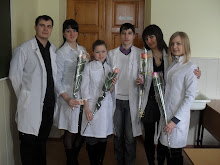3 Americans Share Nobel for Medicine
The Nobel Prize in Physiology or Medicine was awarded Monday to three American scientists who solved a problem of cell biology with deep relevance to cancer and aging. The three will receive equal shares of a prize worth around $1.4 million. The recipients solved a longstanding puzzle involving the ends of chromosomes, the giant molecules of DNA that embody the genetic information. These ends, called telomeres, get shorter each time a cell divides and so serve as a kind of clock that counts off the cell’s allotted span of life. The discoveries were made some 20 years ago in pursuit of a purely scientific problem that seemingly had no practical relevance. But telomeres have turned out to play a role in two medical areas of vast importance, those of aging and cancer, because of their role in limiting the number of times a cell can divide.
“I am thrilled that the basic science can be celebrated,” Dr. Greider said in an interview Monday.
Only eight women had won the Nobel Prize in Physiology or Medicine. Asked how she felt about becoming No. 9, Dr. Blackburn replied, “Very excited, and hoping that nine will quickly become a larger number.”
Thomas Cech, a Nobel Prize winner at the University of Colorado, said the discovery had had a broad impact on several fields of biology and medicine and had also provided a “fascinating insight” into the transition between the DNA world and the RNA world that preceded it in the origin of life. RNA is a close chemical cousin of DNA. Though Americans have again made a clean sweep of the Nobel medicine prize, two of the three winners are immigrants. Dr. Blackburn was born in Tasmania, Australia, and has dual citizenship; Dr. Szostak was born in London. Dr. Blackburn came to the United States in the 1970s because it was “notably attractive” as a place to do science. While America is still a magnet for foreign scientists, she said, “one shouldn’t take that for granted.”
Dr. Szostak also said the world was now more competitive in science. “So maybe we have to work a little harder to attract people from around the world and make sure they stay here,” he said.
Dr. Cech, former president of the Howard Hughes Medical Institute, said the more onerous visa requirements imposed on foreign scientists in the wake of the Sept. 11 attacks were benefiting European countries especially. “Even now, there is an implication when foreign scientists apply for visas that they should be distrusted, denied several times, and should have to hire lawyers and jump through a lot of hoops,” he said. All three of the prize winners seem to have had science in their genes, and certainly in their home environment. Dr. Greider is the daughter of two scientists with doctorates from the University of California, Berkeley, and she, too, has a Ph.D. from there. Dr. Szostak’s father was an engineer. Both of Dr. Blackburn’s parents were physicians. The study of telomeres is notable as a field of research in which female scientists are particularly prominent. Dr. Greider said she ascribed this to a “founder effect,” the founder being Joseph Gall of Yale University. Dr. Gall trained Dr. Blackburn and other women, and they recruited others to the field “because there is a slight tendency for women to work with other women,” Dr. Greider said. She herself trained with Dr. Blackburn. Dr. Blackburn addressed this problem by working with a single-cell organism found in pond water known as Tetrahymena. She found in 1978 that the telomeres had a very unusual structure, in which the same sequence of six DNA units was repeated some 50 times.
She and Dr. Szostak, who with her help had detected telomeres in yeast, then proposed that cells must possess a special enzyme that added these repeat units to the end of chromosomes so as to compensate for the incomplete job done by the copying enzyme.
Working in Dr. Blackburn’s lab as a graduate student, Dr. Greider tracked down this enzyme, now known as telomerase, in a central experiment that finished on Christmas Day, 1984. Going into the lab that morning, Dr. Greider saw from the telltale signature of the six-unit repeat that she had captured telomerase. “That was a really exciting day,” she said.
Later she found that telomerase contains a special piece of RNA that it uses as a template to elongate the chromosome with the six-unit repeats. The unexpected involvement of RNA reflects a time early in the origin of life when all the important chores in the cell were performed by RNA, not DNA.
This piece of basic biology soon turned out to have important implications for aging and cancer. Telomerase is usually active only at the beginning of life; thereafter the telomeres get shorter each time a cell divides. If they get too short, a cell is thrown into senescence, meaning that it cannot divide again.
Both Dr. Blackburn and Dr. Greider still work on telomerase, but Dr. Szostak left the field 20 years ago to explore a much broader question: how life could have originated from the simple chemicals present on the early earth. He has already made advances in this long intractable field, notably by showing how a proto-cell could have formed and then imported the RNA building blocks. Dr. Szostak hopes next to show how the proto-cell and its RNA could divide naturally into two daughter cells, a feat that, if achieved, could well be a candidate for a second Nobel Prize.


